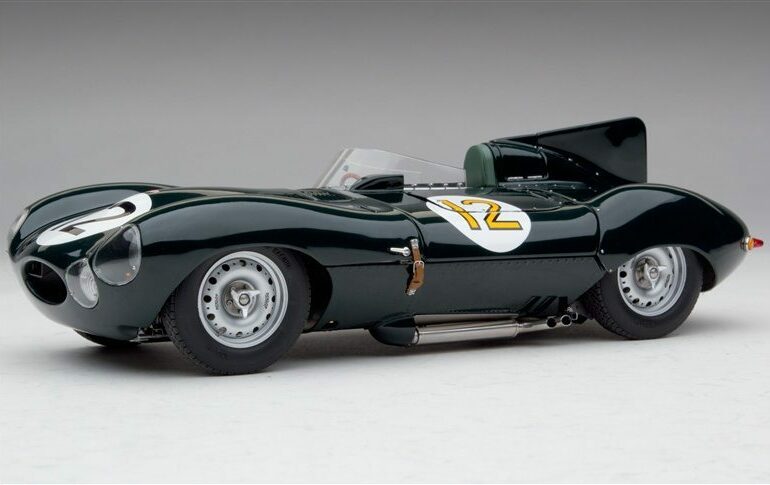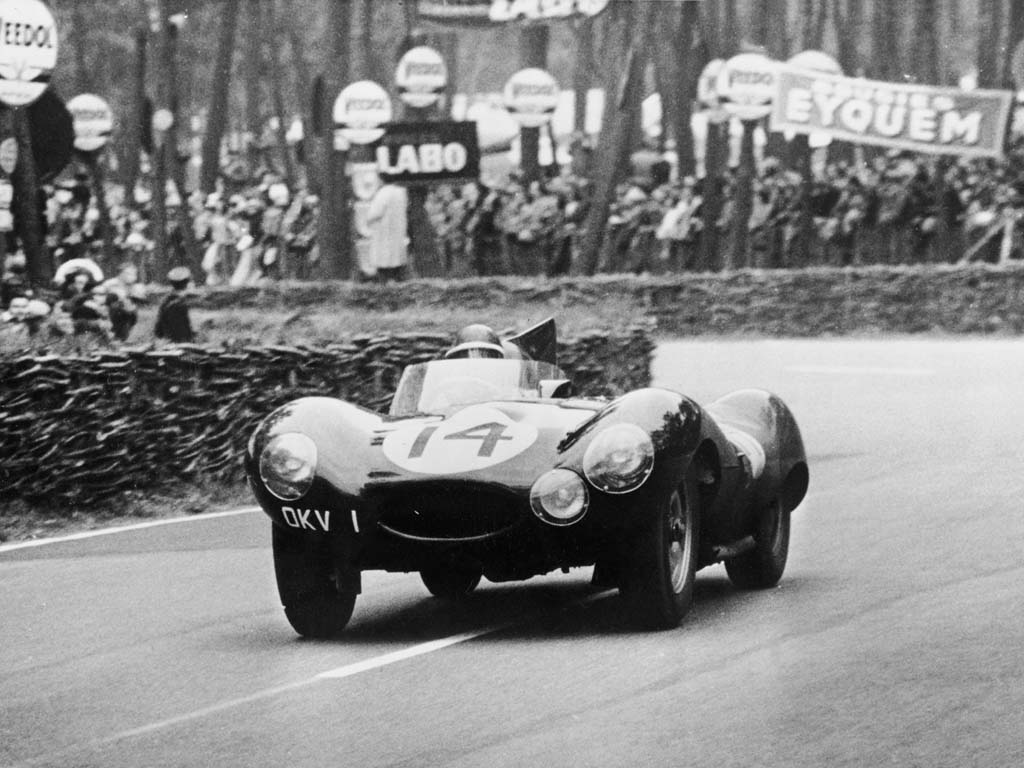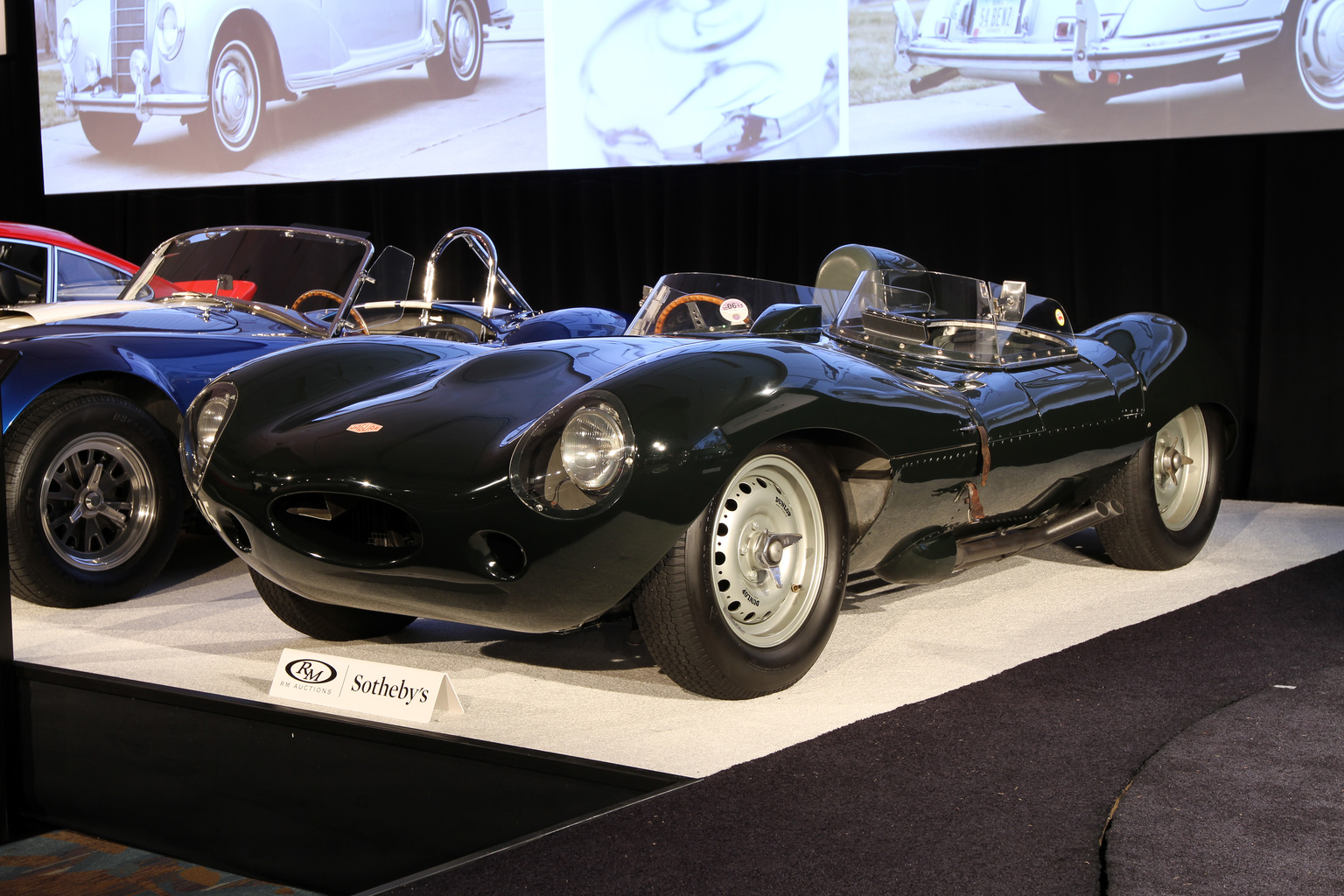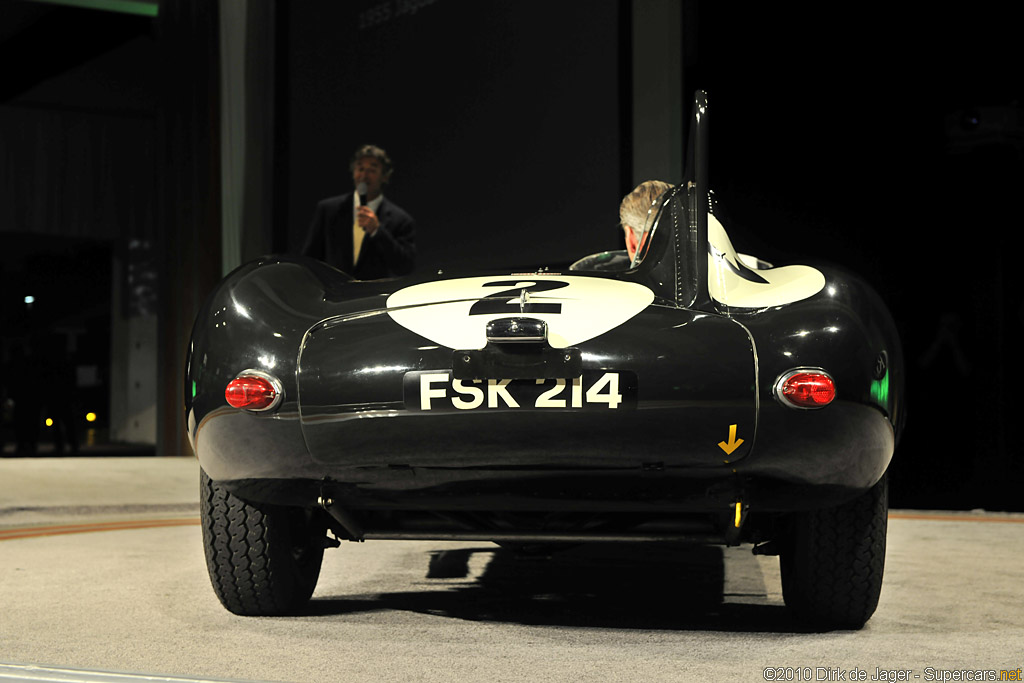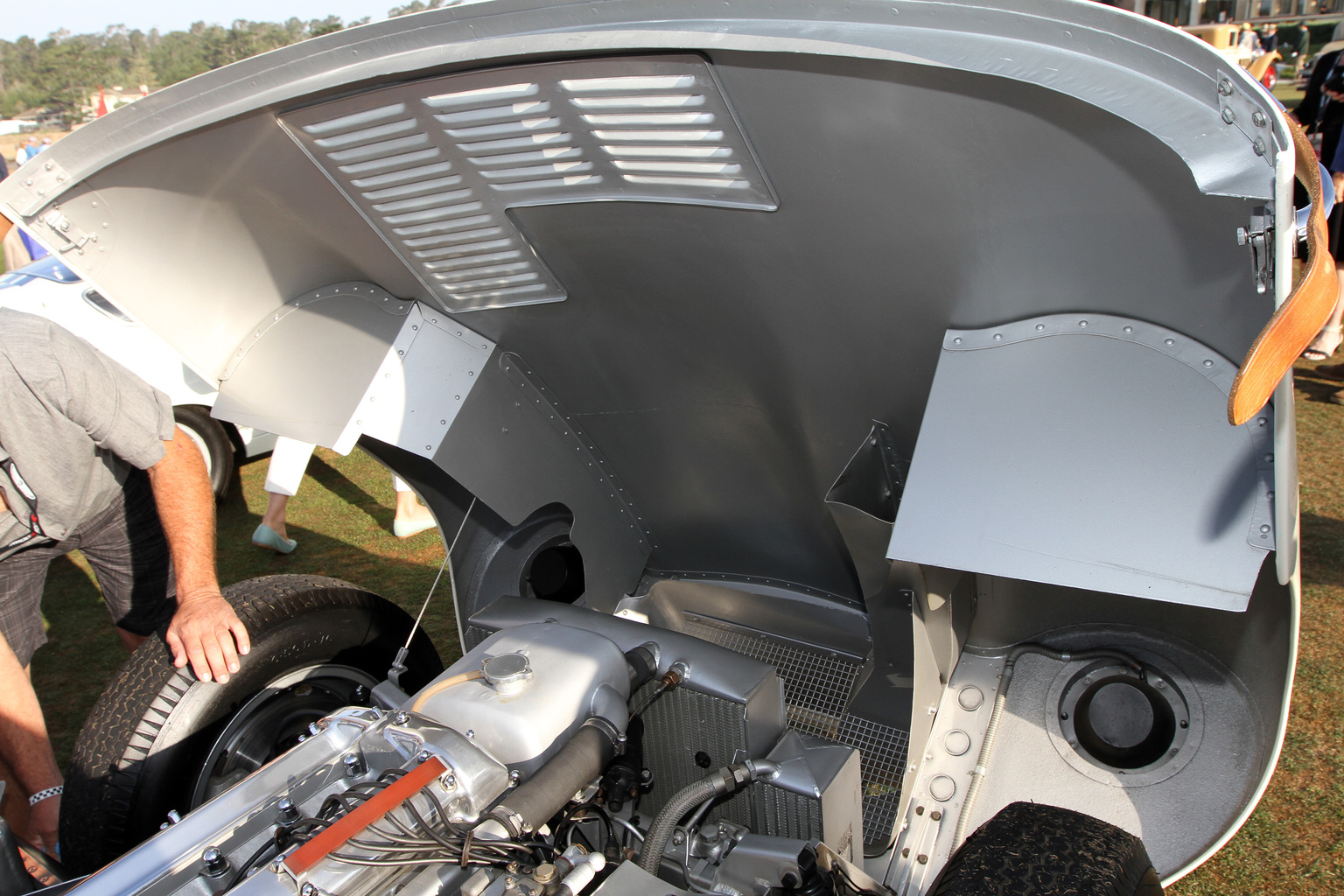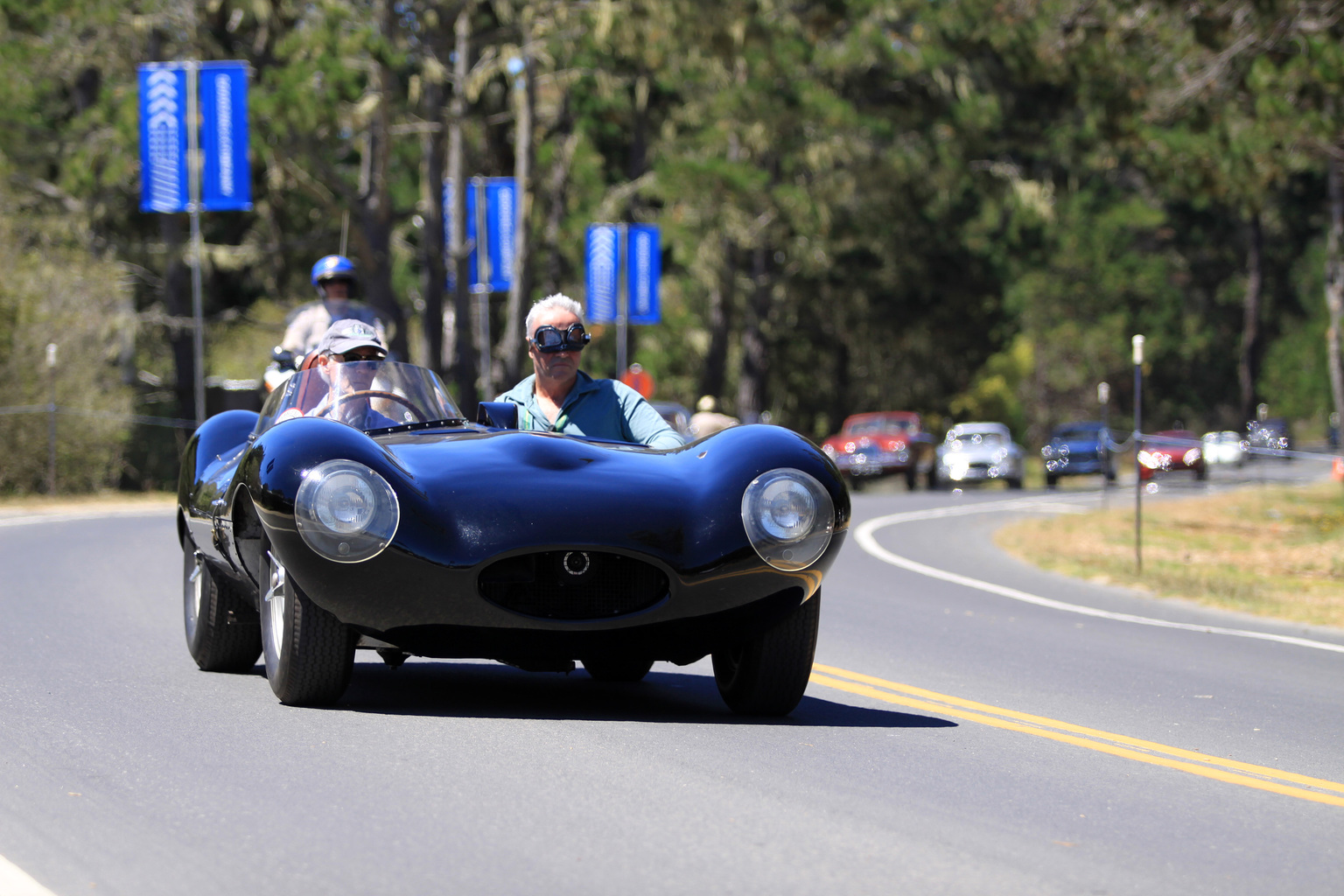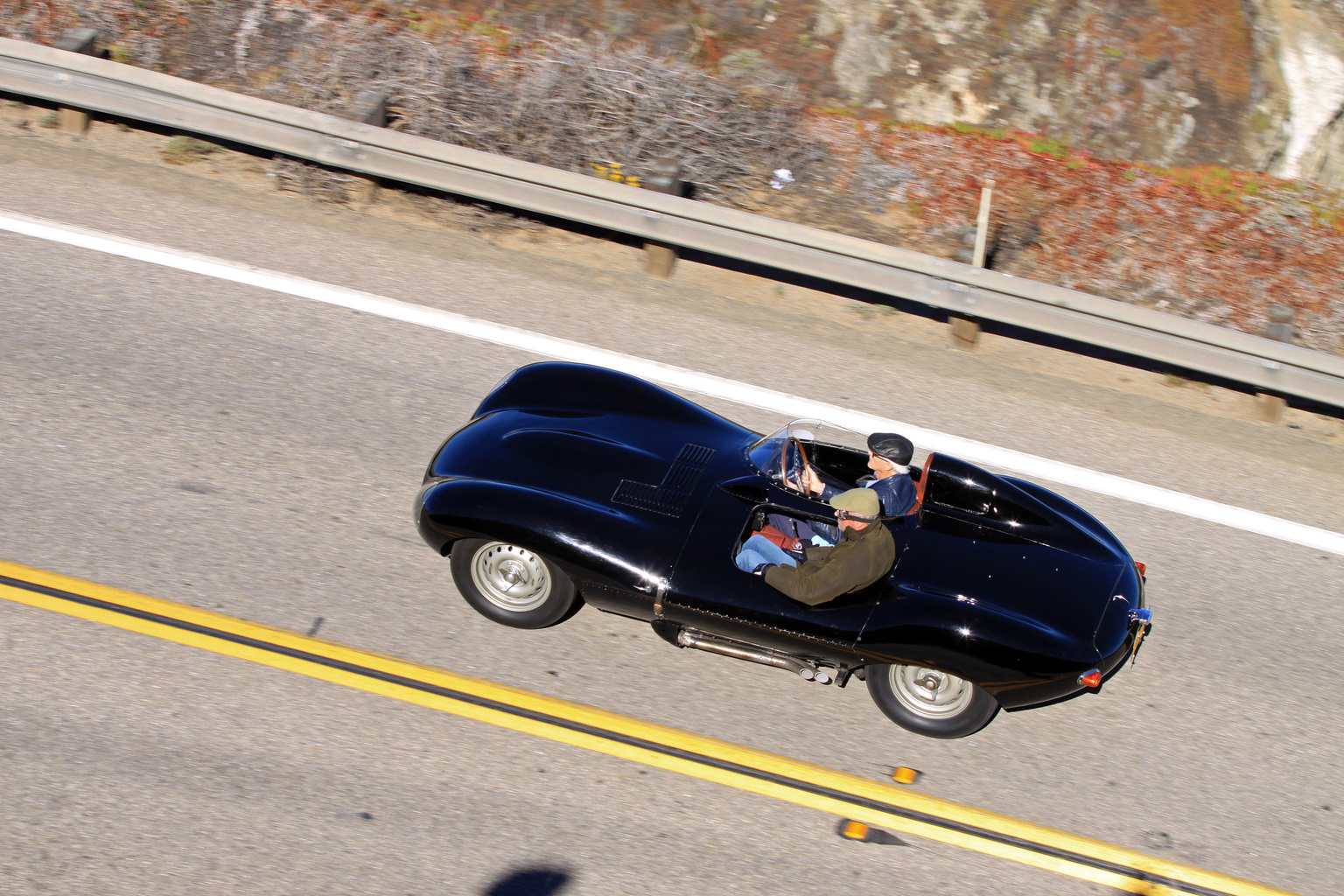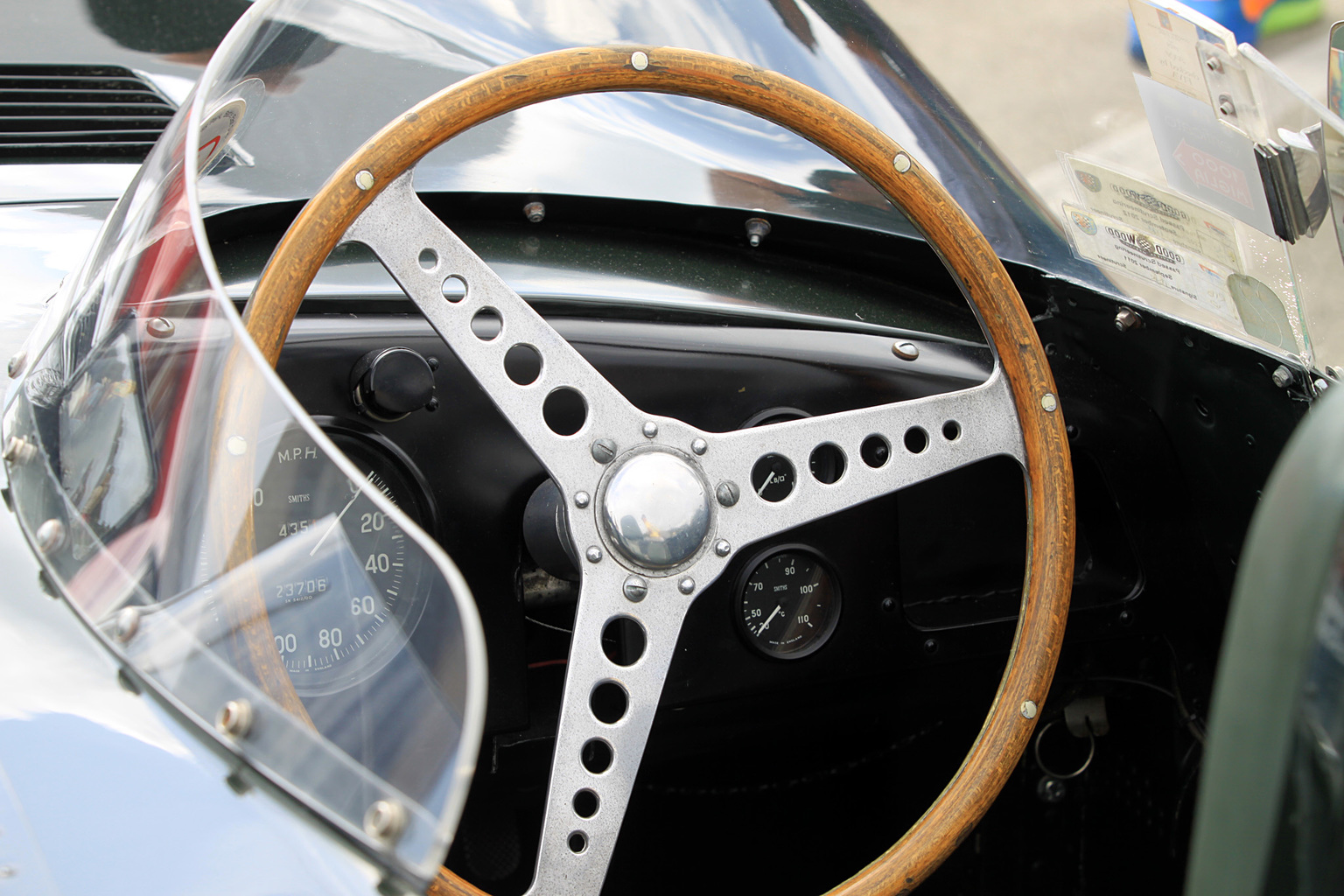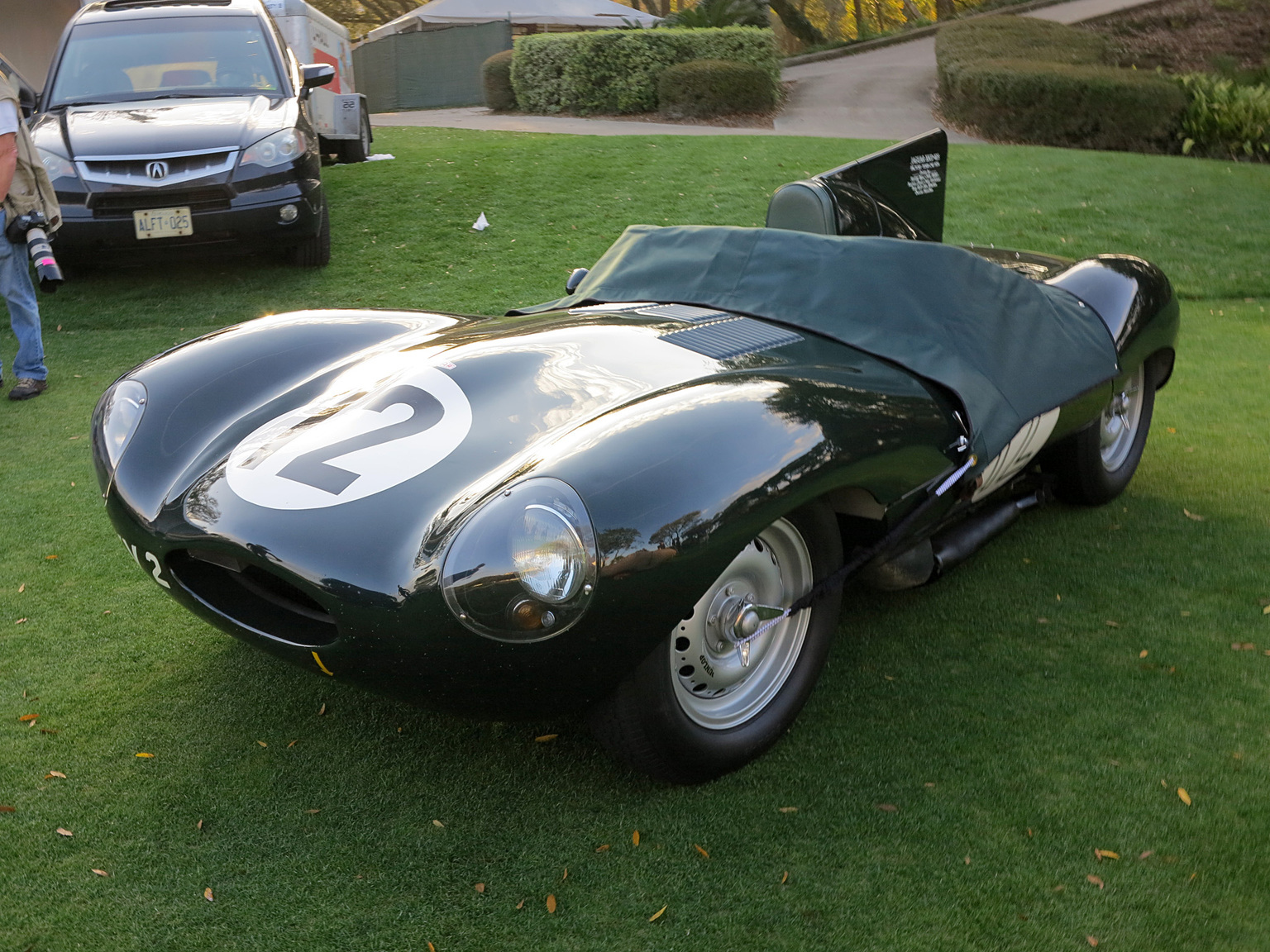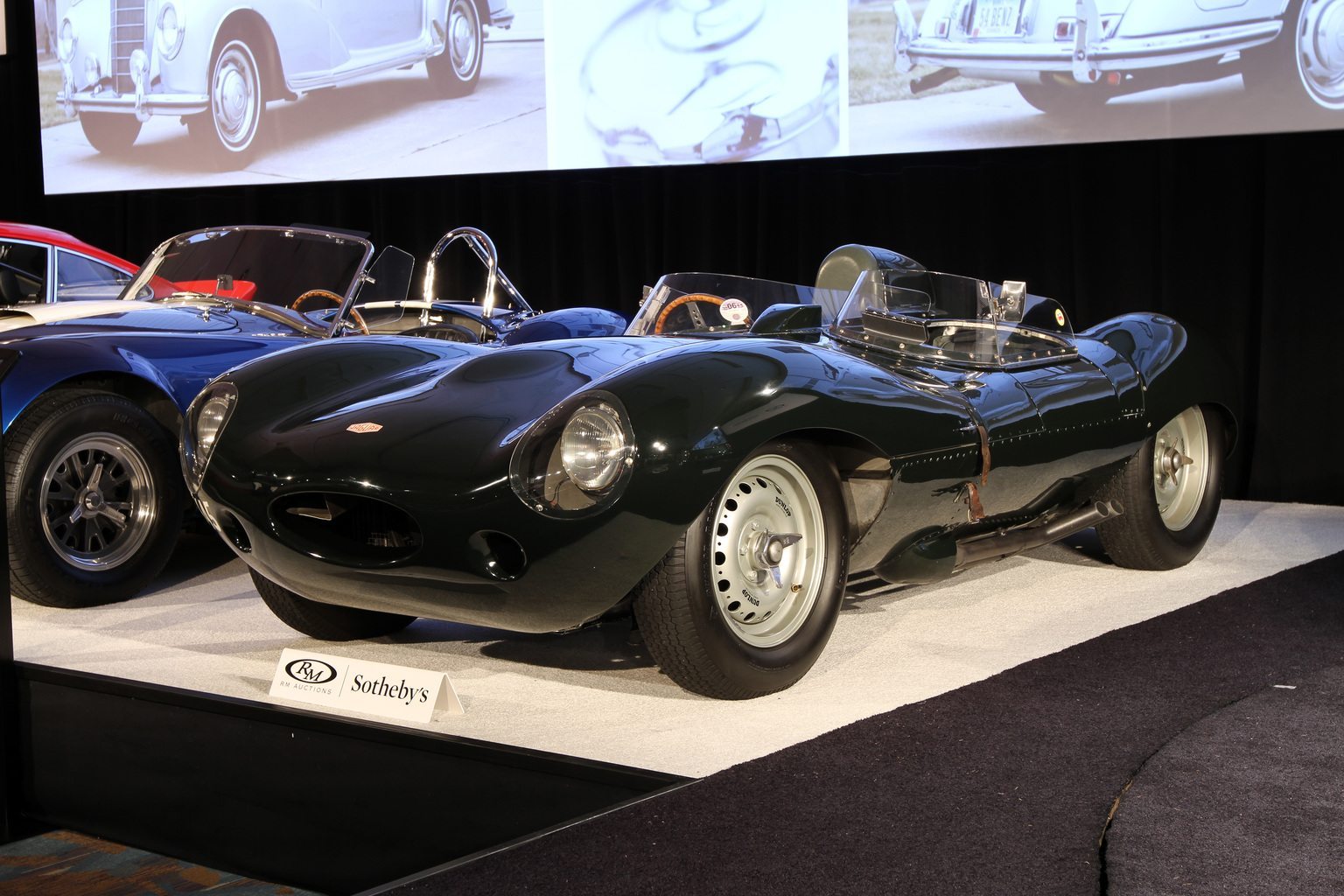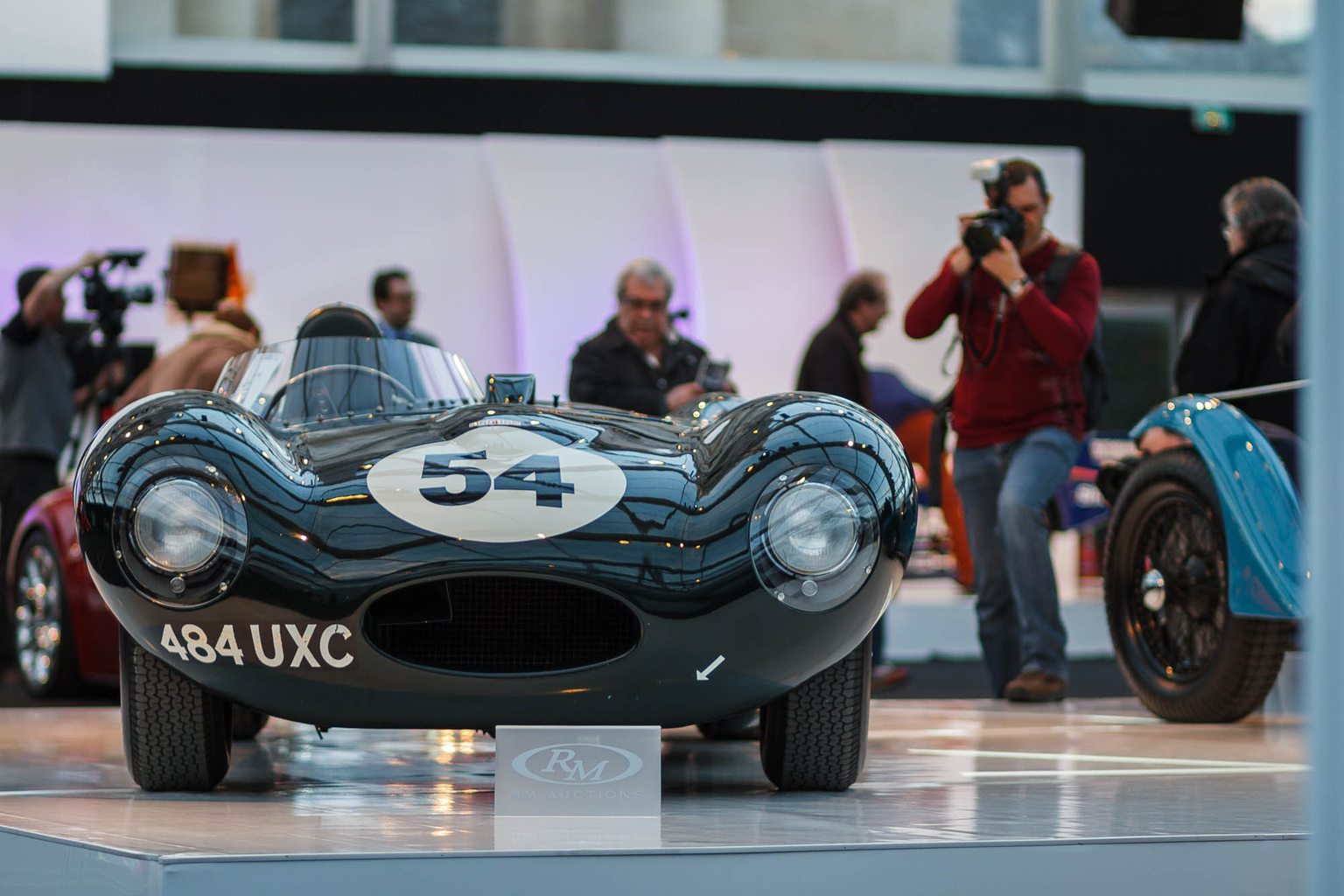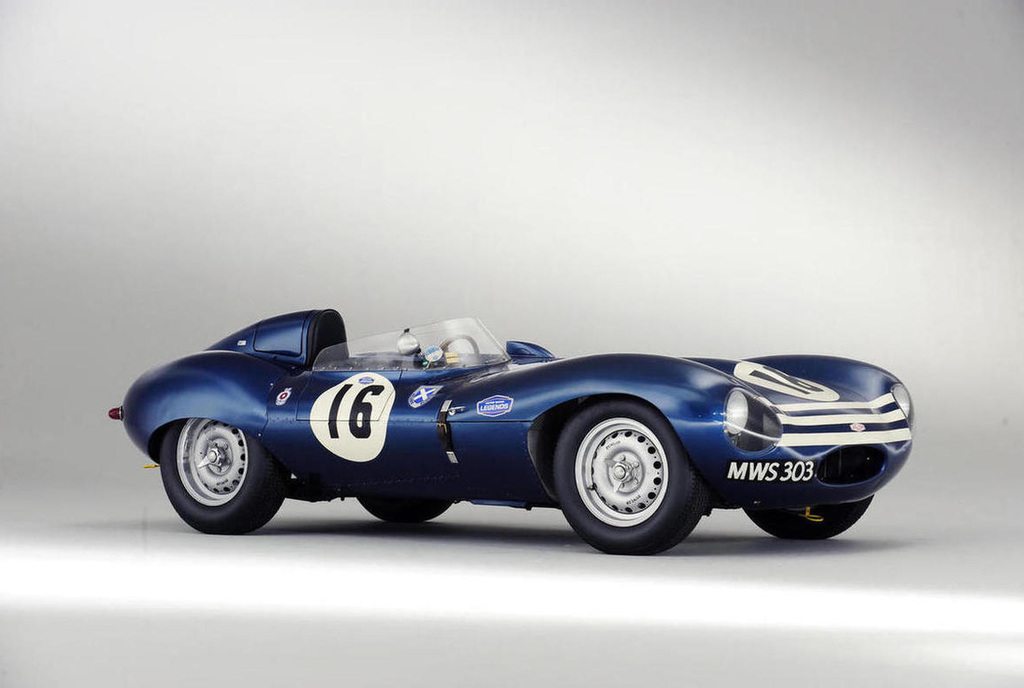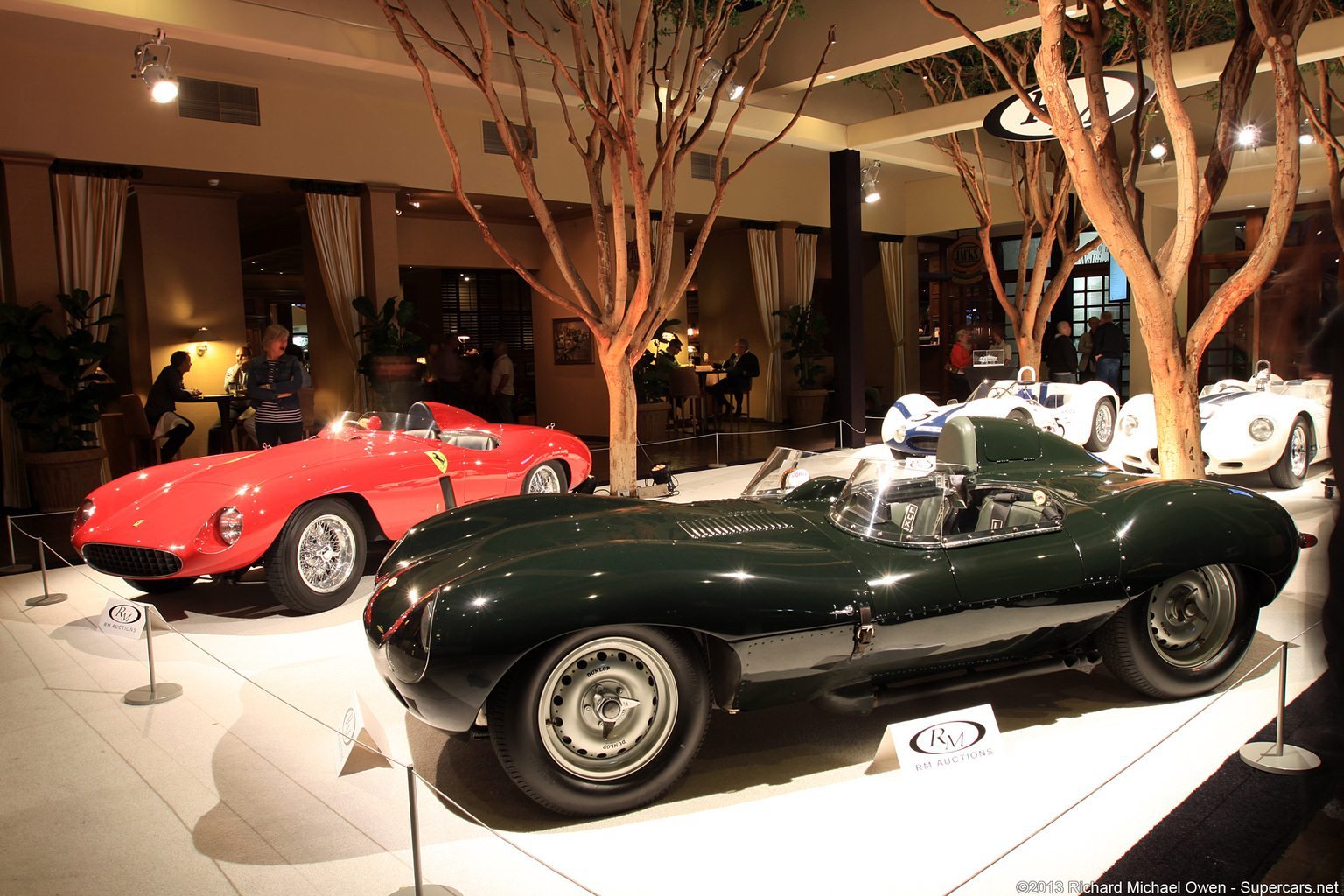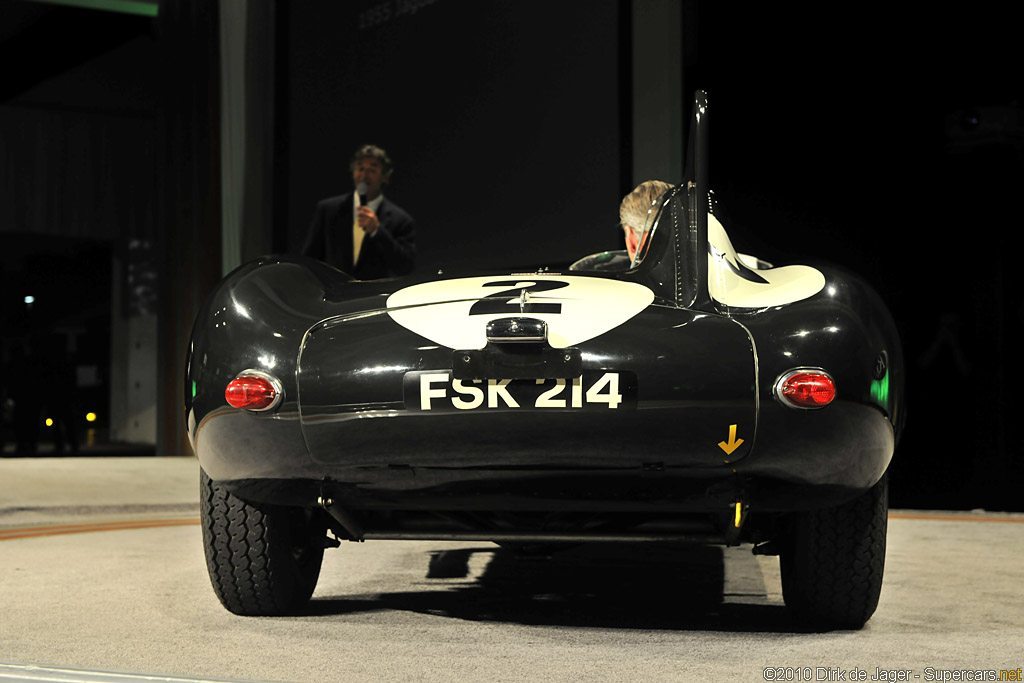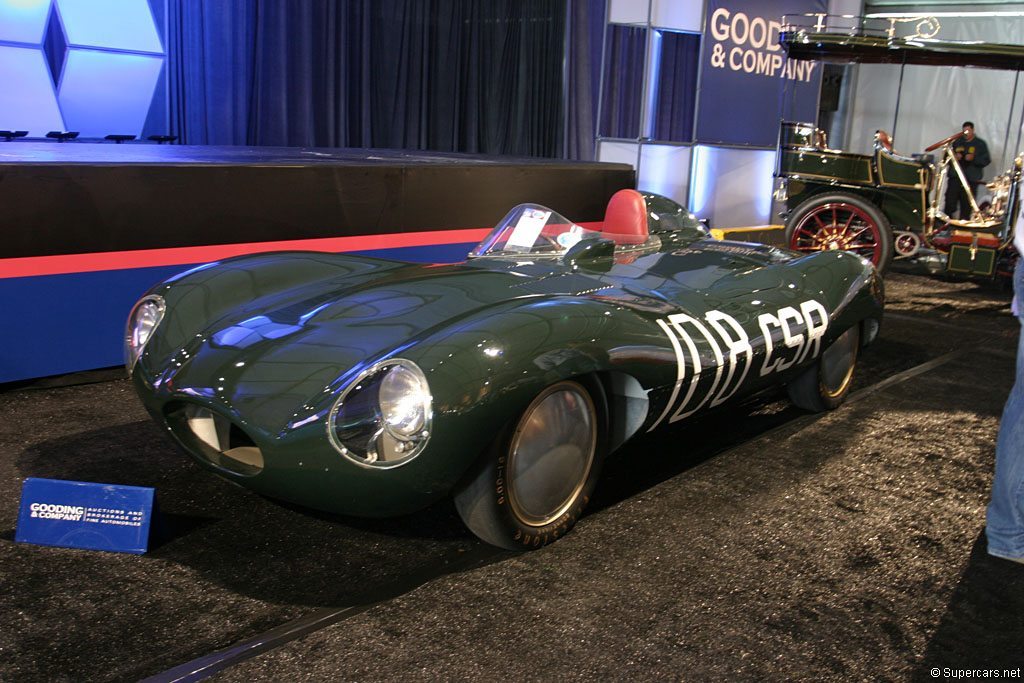1954 Jaguar D-Type
Continuing their successful motor sports program, Jaguar created the D-Type as a logical progression of the XK120C, or C-Type. After an eighteen month development period, the D-Type was launched and intended to assault the 1954 Le Mans. It won the event three years in a row and became Jaguar’s most successful race car.
After three privately entered XK120s proved competitive at LeMans, Jaguar was motivated to move forward with their own purpose built race car. The result was the XK120C, a car which would win at its very first event, the 1951 24 Hour of Le Mans. This result was achieved again in 1953, with the final version of the XK120-C which featured disc brakes – an automotive first in GT racing.
Even before 1953 victory at Le Mans, it became clear to Jaguar that a new car would be necessary to stay ahead of Ferrari, Alfa Romeo, Aston Martin and Maserati. Sir Williams Lyons, the founder of Jaguar, assembled a team of Engineers including Malcom Sayer, an aviation aero dynamist, to create the all-new D-Type.
D-Type Engineering
Design requirements for the D-Type said it should be lower and shorter that its predecessor. This would help the car achieve a higher top speed and increased cornering capability. Most of the form for the car came from mathematical computation with the help of Malcom Sayer. Initial tests on the unpainted prototype car, chassis XKC401, revealed a top speed of 178 mph, almost 30mph faster than the Type-C!
At the heart of the D-Type was an innovative chassis structure. It used stressed-skin engineering, incorporating the framework with riveted aluminum body panels to form a single rigid structure. Such design made the D-Type one of the first cars to use monocoque construction. As on the C-Type, both the front and rear panels of the car remained unstressed and easily removable for repairs.
The 1954 D-Type used a magnesium alloy for it’s body, framework and suspension. While this did keep weight down, it made production expensive and repairs even more expensive. By 1955 these materials were replaced by simple aluminum and steel counterparts.
The XK-based engine powering the D-Type played a large role in helping achieve a high top speed. It was both shorter, thanks to dry-sump lubrication, and more powerful than the previous engines. The combination of a revised block, larger valves and triple Weber carburetors helped the engine achieve 245 bhp.
Dunlop disc brakes were employed to all four wheels. Jaguar worked exclusively with Dunlop during the fifties to adapt aircraft disc brakes to road cars. In 1953 the first use of disc brakes was witnessed on the C-Type works cars. It was this potent feature that helped the C-Type achieve victory at the 1953 Lemans.
Suspension of the D-Type type used double wishbones up front with a rigid axle in the rear. This was the familiar setup found on all production Jaguars during the period.
1954 Jaguar D-Type Image Gallery
See Full Jaguar D-Type Image Gallery
Racing
Despite being created even before the 1953 Le Mans, the D-Type made it first appearance the following year. Three chassis, #402, #403 and #404 were created after the prototype to specifically race in the 1954 24 Hours of Le Mans.
Driving the three cars were teams made up of Tony Rold with Duncan Hamilton, Stirling Moss with Peter Walker and Peter Whitehead with Ken Wharton. Unfortunately, two cars dropped out early with brake and transmission problems. The final car, driven by Hamilton and Rolt showed promising resilience, but ended up finishing two minutes behind a 4.9-liter Ferrari. It was one of the closest finishes ever and a bitter disappointment for Jaguar who made Le Mans the point of their competition effort.
Jaguar made up for their losses in 1955, but it was completely overshadowed by the Le Mans tragedy and was only possible with the the withdrawal of Daimler-Benz A.G. and their Mercedes-Benz 300 SLR.
In 1956, Jaguar officially supported teams such as Ecurie Ecosse while they converted the racing department into developing the E-Type. During this time several updates were carried out on the D-Type to keep it competitive. With private entrant E-Types won Le Mans outright with Ecurie Ecosse in 1956 and 1957. During the later, they swept the podium at the 1956 24 Hours of Le Mans with Ron Flockhart and Ivor Bueb of Ecurie Ecosse winning outright. Late in 1957 Jaguar was even considering making a fiberglass body for the 1958 car.1
Sources & Further Reading
1. Porter, Philip. Jaguar E-Type The Definitive History. Foulis: 1989.
In Detail
| type | Racing Car |
| built at | Coventry, England |
| engine | Cast Iron Inline-6 |
| position | Front Longitudinal |
| aspiration | Natural |
| valvetrain | DOHC 2 Valves / Cyl |
| fuel feed | 3 Weber 45 DC03 3 Weber DC03 Carburetors |
| displacement | 3442 cc / 210.0 in³ |
| bore | 83 mm / 3.27 in |
| stroke | 106 mm / 4.17 in |
| compression | 9.0:1 |
| power | 182.7 kw / 245 bhp @ 6500 rpm |
| specific output | 71.18 bhp per litre |
| bhp/weight | 291.67 bhp per tonne |
| torque | 325.4 nm / 240 ft lbs |
| body / frame | Magnesium Alloy Monocoque w/Steel Front Subframe |
| driven wheels | RWD |
| front tires | 6.5×16 |
| rear tires | 6.5×16 |
| front brakes | Dunlop Discs |
| rear brakes | Dunlop Discs |
| front wheels | F 40.6 x 14.0 cm / 16 x 5.5 in |
| rear wheels | R 40.6 x 14.0 cm / 16 x 5.5 in |
| steering | Rack & Pinion |
| f suspension | Double Wishbones w/Torsion Bars, Telescopic Dampers |
| r suspension | Solid Axle w/Trailing Links, Transverse Torsion Bar, Telescopic Dampers |
| curb weight | 840 kg / 1852 lbs |
| wheelbase | 2300 mm / 90.6 in |
| front track | 1270 mm / 50.0 in |
| rear track | 1219 mm / 48.0 in |
| length | 3912 mm / 154.0 in |
| width | 1664 mm / 65.5 in |
| height | 1372 mm / 54.0 in |
| transmission | 4-Speed Manual |
| final drive | 3.54:1 |
| top speed | ~280.0 kph / 174 mph |
| 0 – 60 mph | ~7.0 seconds |
| key drivers | Ivor Bueb, Mike Hawthorn, Ron Flockhart |
Auction Sales History
1955 Jaguar D-Type XKD 530 – sold for $3,675,000 Extensively documented; multiple in-period 1st place finishes. Comprehensive restoration in 2003 by noted D-Type expert. Subject of a five-part feature series in Jaguar World Monthly. Vintage racing participation, including at the Mille Miglia and Goodwood Revival. Accompanied by a FIVA Passport, FIA papers, and a JDHT Certificate. Auction Source: 2015 Amelia Island by RM Sotheby’s
1955 Jaguar D-Type XKD520 – sold for €3,696,000 Highly original example with period race history. The seventh customer D-Type produced. Delivered new and raced by four-time Australian Drivers’ Champion Bib Stillwell. Owned by 1970 Le Mans winner Richard Attwood. Decades of care by marque expert Chris Keith-Lucas. Jaguar’s most iconic sports racing model.
Auction Source: 2014 Paris by RM Auctions
1956 Jaguar D-Type XKD561 – sold for €3,100,000 The Ex-Ron Flockhart, Ninian Sanderson, Jock Lawrence. Well-presented, long-dormant, wonderfully well-restored and race proven Ecurie Ecosse D-Type Jaguar. One of the most authentic Jaguar D-Type Jaguars to have survived from period competition use. Restored by leading British Jaguar specialist John Pearson. Fitted with a correct spec. D-Type six-cylinder racing engine fully prepared and tuned by Sigma Engineering. Its 1959-60 period ex-Maurice Charles engine serial number ‘E2010-9’ – is also included. Auction Source: Bonhams splits up the Ecurie Ecosse Collection
1955 Jaguar D-Type XKD530 – sold for $3,905,000 Extensively documented; multiple in-period 1st place finishes. Comprehensive restoration in 2003 by noted D-Type expert. Subject of a five-part feature series in Jaguar World Monthly. Exhibited at Pebble Beach, Villa d’Este, and Amelia Island. Vintage racing participation, including the Mille Miglia and Goodwood Revival. FIVA Passport, FIA papers, and JDHT Certificate. Auction Source: 2013 Monterey Auction by RM Auctions
1955 Jaguar D-Type XKD558 – sold for $2,090,000 Offered from the collection of Jerry and Kathy Nell. Complete with original engine. Well documented and successful racing history. The ownership chain of XKD 558 is sound and unbroken. Careful corrections to its early racing career and its post-crash state in 1964 have been made possible by the careful research and fastidious recordkeeping of its very knowledgeable and discerning owner, Kathy Nell, who has owned the car with her late husband Jerry for the past decade. Serious Jaguar collectors in every respect, the Nells are one of a limited few to have owned a C-Type, D-Type and XK-SS – the holy grail of desirable Jaguar collector cars. XKD 558 is also accompanied by its originally installed racing engine and original chassis plate. This is without exaggeration one of the most enduring, exciting and rare legends in the history of motorsports. Auction Source: RM Auctions’ 2010 Sports & Classics of Monterey
1955 Jaguar D-Type XKD529 – sold for $1,815,000 In original form, this car with chassis number XKD529 was driven in US sports car races by the unbeaten Walt Hansgen and by others. Then, in 1959, it was fitted with a new 3.8-liter engine and a 2.53 rear axle ratio and was further modified aerodynamically for a speed attempt at Bonneville. There it achieved a top speed of 185.47 mph, making it the fastest Jaguar D-Type in the world. Auction Source: 2005 Monterey Events


